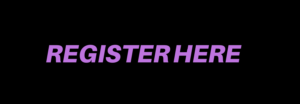Join us for an opening reception to celebrate and kick off our fall/winter exhibitions alongside curators Rikki Byrd, and Gervais Marsh, with artist Cory Perry!
All of Living is Risk (2nd floor Cortor Gallery) brings together works by Cory Perry (b. 1989, Fayetteville, Arkansas) and Nnaemeka C. Ekwelum (b. 1990, Boston). Drawing on Afrodiasporic textile practices of quilting and weaving, respectively, Perry and Ekwelum explore the juxtaposition of Black queer grief, joy, and belonging. Combining second-hand textiles and deconstructed clothing objects given to them by Black queer people whose voices have been underrepresented across the South – and specifically in their hometown of Fayetteville, Arkansas – Perry pays homage to the region’s traditions of quilting. Strung along and suspended from string, Perry’s installation recalls a clothesline. They critically engage quotidian and gendered gestures of homemaking to reflect on the ways that queer people in the South build relationships and foster collectivity, despite the ruptures and ephemerality of these spaces caused by harmful societal reactions attempting to stifle their existence.
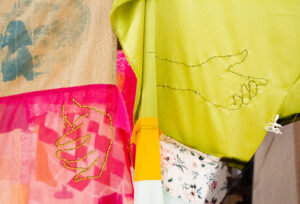
Image courtesy of artist Cory Perry. 2023.
Ekwelum creates grief cloths using a West African upright loom inspired by Nigerian “abata” cloths, which are used to honor the dead during funerals. The artist extends the intent of these cloths as an archive of feeling to consider his life as a Black queer American-born, Nigerian person. Combining weaving, sculpture, and installation, found and purchased art materials, Ekwelum’s practice puts pressure on and blurs the antiquated delineation between craft and fine art. Central to his artistic materials is a plastic lacing known as “gimp.” Often considered a tool for creative experimentation for children, the artist uses it to represent his “inner child work.” In this exhibition and others, Ekwelum “moves according to feeling,” sculpting each cloth in response to gallery architecture, exhibition themes, and history of location. Perry and Ekwelum engage textiles and found objects as conduits for histories imbued with personal memories, delving into the interiority of Black queer life. They meditate on what cannot be immediately “seen” or “known”, and imagine possibilities for healing while creating spaces for living through joy and collective care.
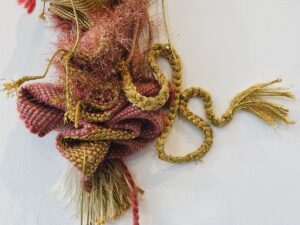
Image courtesy of Nnaemeka C. Ekwelum. 2023.
Visitors are invited to gently move their bodies through Perry’s installation and closely observe Ekwelum’s cloths, inspiring the beauty of wonderment. Please honor their practices while being respectful and careful with their work. This exhibition is titled after scholar Kevin Quashie’s reflection in his essay “Queer. Caribbean. Miami. Boy: A Personal Geography”: “The truth is, all of living is risk, sometimes more so because of one’s age, gender, race, but all of living is deep risk.”
It is organized by independent curators Gervais Marsh and Rikki Byrd with support by the South Side Community Art Center, Art Noir Jar of Love Fund, and the Black Arts Consortium at Northwestern University.
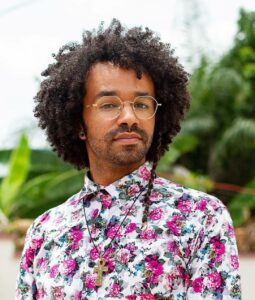
Cory D. Perry (b. 1989, Arkansas) is a multimedia quilting and performance folk artist based in Chicago, IL. My art practice and research investigate the possibilities of what queering Black spiritual space can and could be through textiles, images, beads, and various materials. They received their Bachelor of Fine Arts from the University of Arkansas School of Art and attended the Post-baccalaureate program in Sculpture and Museum Research at the Kwame Nkrumah University of Science and Technology in Kumasi, Ghana. Perry received their Master’s degree of Fine Arts and graduate certificate of Black Studies from Northwestern University. Perry is a recipient of the 2019 Windgate-Lamar Fellowship and the 2022 Sexualities Project at Northwestern University Award. In 2019 they were an honorary international artist for Chale Wote Performance Art Festival in Accra, Ghana. Most recently, they were a participant artist for the 2023 Smithsonian Folklife Festival, where they created and performed “Queer Black Sunshine” a meditative protest on the National Mall in Washington, DC.
“My art practice and research investigates ways to expand the possibilities of what Black queer space can and could be through textiles, images, beads, and various materials. For me, “to be Black and queer” is the potentiality of another world through self-identifying and self-actualizing gestures. I’m interested in what the materials can tell us through their palimpsest beauty. By layering various translucent textiles and allowing collaged fabrics to shift in composition from different perspectives, windows are created for the seen and unseen. Black queer space is always in a state of flux, and I want to explore that in my work.”
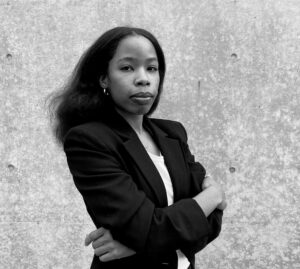
Rikki Byrd is a writer, educator and curator who works across the academy, arts and fashion industries. She has participated in curatorial projects with the Block Museum of Art, SkyART, and most recently curated the fashion presentations in the traveling exhibition The Culture: Hip Hop & Contemporary Art in the 21st Century, co-organized by the Baltimore Museum of Art and Saint Louis Art Museum. Her research focuses on Black aesthetic practices including fashion, performance, and contemporary art, and she has lectured at the School of the Art Institute of Chicago and Washington University in St. Louis, where she created new courses on fashion and race. Her writing appears across exhibition catalogs, academic journals, books, and arts and fashion media such as Hyperallergic, Cultured and Teen Vogue.
She is the co-founder and editor of the Fashion and Race Syllabus, founder of Black Fashion Archive, and an editorial advisory board member for Bloomsbury Fashion Publishing. Rikki is currently completing her PhD in the Department of Black Studies at Northwestern University. Her work has been supported by fellowships from the Modern Ancient Brown Foundation, Robert Rauschenberg Foundation, and the Presidential Fellowship at Northwestern University.

Gervais Marsh is a writer, curator and scholar whose work is deeply invested in Black life, concepts of relationality and care. They received a PhD in Performance Studies from Northwestern University and are currently a Helena Rubinstein Curatorial Fellow with the Whitney Museum Independent Study Program. Their writing, artistic and curatorial work is rooted in Transnational Black feminisms, with recent curatorial projects including To be pained is to have lived through feeling with Canada NYC and Rupture: Interventions of Possibility with Art at a Time Like This. Their writing has been published in several books and exhibition catalogs including Denzil Hurley (monograph), Nka: Journal of Contemporary African Art, Forgotten Lands Vol. 5, KMAC Museum Triennial (2022), as well as online art publications such as Hyperallergic, C Magazine, Brooklyn Rail, ARTS.BLACK, Musée Magazine, and PREE: Caribbean Writing, among others. They have received fellowships and curatorial support from the Jamaica Art Society, Terra Foundation for American Art, VisArts Center, The Gay and Lesbian Review, Northwestern University, and Independent Curators International.
They have taught undergraduate/graduate courses focused on Black Feminist theory, praxis and performance, and Black queer studies. They are an editor with Ruckus Journal and research interests include Black Studies, Art history, Caribbean Studies and Gender and Sexuality Studies. They grew up in Kingston, Jamaica, a home that continues to shape their understanding of self and relationship to the world.



